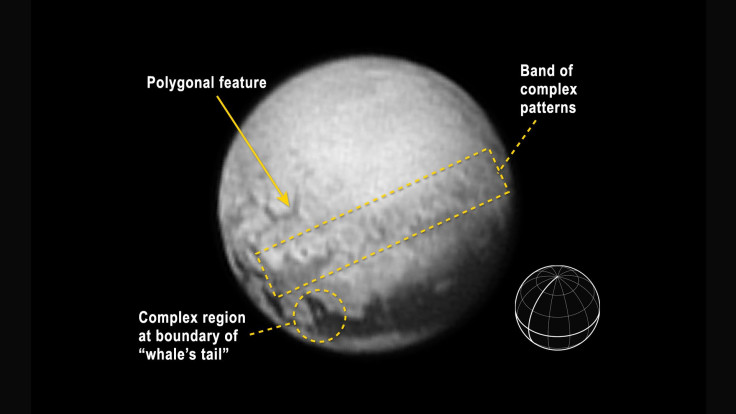New Horizons Update: Latest Pluto Images Reveal 'Tantalizing' Surface Features

With just three days left for New Horizons’ historic flyby of Pluto, the NASA spacecraft has started discerning surface features on the distant dwarf planet. Of particular interest now is an elongated dark band -- “the whale” -- detected earlier this week by the Long Range Reconnaissance Imager (Lorri) aboard the spacecraft.
“We’re close enough now that we’re just starting to see Pluto’s geology,” Curt Niebur, New Horizons' program scientist, said in a statement released Saturday. “[The whale’s tail feature] is a unique transition region with a lot of dynamic processes interacting, which makes it of particular scientific interest.”
The whale, a region nearly 1,860 miles in length, is the darkest region spotted on the dwarf planet so far. The brightest region visible on the planet lies to the right of the whale’s “head.” Based on data available currently, scientists believe that the region is covered with a bright, reflective coating of frost -- composed of frozen methane, nitrogen and possibly carbon monoxide.
“Among the structures tentatively identified in this new image are what appear to be polygonal features; a complex band of terrain stretching east-northeast across the planet, approximately 1,000 miles long; and a complex region where bright terrains meet the dark terrains of the whale,” Alan Stern, New Horizons' principal investigator, said in the statement.

The above image was taken on July 9 from a distance of about 3.3 million miles. Next week, New Horizons, which was launched in 2006, is expected to pass within 7,800 miles of the dwarf planet’s surface, revealing its “complex and nuanced surface” in further, unprecedented detail.
New Horizons’ closest approach to Pluto will be at 7:49 a.m. EDT on Tuesday, July 14, 2015.
Given its distance from the sun, Pluto -- which was demoted from planet status in 2006 -- is shrouded in darkness. At its average distance, sunlight takes about 5.5 hours to reach the dwarf planet, and for years, astronomers have struggled to discern features on its surface and that on its equally mysterious moon, Charon.
“After nine and a half years in flight, Pluto is well worth the wait,” Stern said.
© Copyright IBTimes 2024. All rights reserved.






















